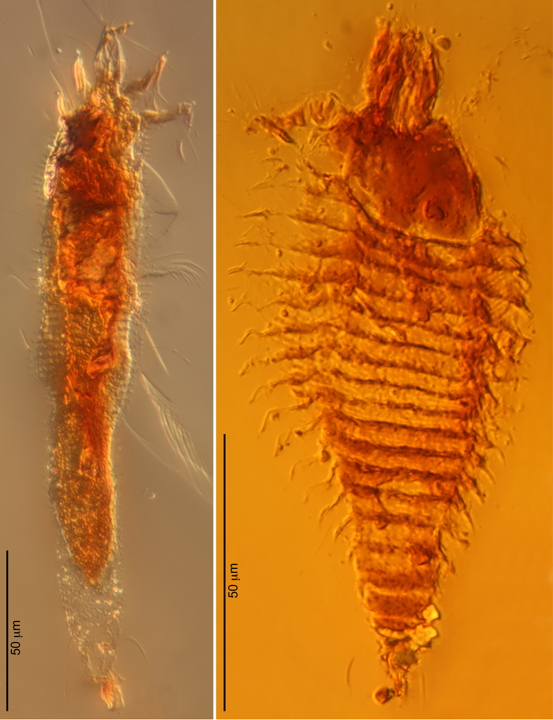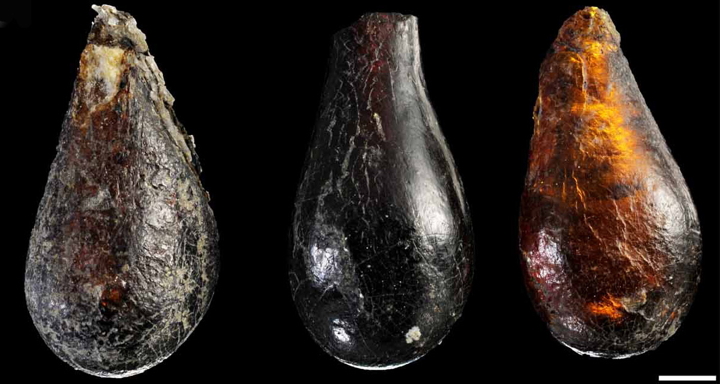230-Million-Year-Old Mite Found in Amber

A long, wormlike, sap-sucking mite is now one of the oldest creepy-crawlies found preserved in amber yet, researchers say.
Insects, spiders and other buglike creatures make up a joint-legged group known as the arthropods. The earliest members of the ancestors of flies and wasps originated near the start of the Triassic period about 250 million years ago, but much remains unknown about the evolution of these and many other groups of insects during this distant era.
"There was a huge change in the flora and fauna in the Triassic because it was right after one of the most profound mass extinctions in history, at the end of the Permian," said researcher David Grimaldi, a curator of invertebrate zoology at the American Museum of Natural History in New York. "It's an important time to study if you want to know how life evolved."
One way to learn more about prehistoric life is amber — fossilized tree resin. Before it hardened, this ooze often dripped over bugs and other wildlife perched on its tree's bark, entombing them for millions of years.
"Amber is an extremely valuable tool for paleontologists because it preserves specimens with microscopic fidelity, allowing uniquely accurate estimates of the amount of evolutionary change over millions of years," Grimaldi said.
Trapped in resin
Scientists have now revealed arthropods trapped in 230-million-year-old amber from northeastern Italy, which appears to hold the most abundant outcrops of Triassic amber in the world. These are the oldest amber-trapped arthropods by about 100 million years, and are the first arthropods to be found in amber from the Triassic, they say. [See Photos of Amber-Trapped Bugs]
Get the world’s most fascinating discoveries delivered straight to your inbox.
"Without question, the most exciting thing is simply that we have established that arthropods can be found in Triassic-aged amber," Grimaldi told LiveScience. Many arthropods are tiny, and all have intricate anatomy, so to have them preserved with lifelike, microscopic fidelity in amber of this age provides a completely new window into the ancient past of arthropods. It's Triassic Park for us paleoentomologists."
The researchers analyzed about 70,000 droplets of amber, each 2 to 6 millimeters long.
"Gathering the amber is simple and fun, though not without its dangers — it's in an absolutely gorgeous section of the Italian Alps, though the outcrops are on steep slopes," Grimaldi said. "Screening the amber required about two years, done by several assistants and students in the lab of my colleague, Alexander Schmidt, in Berlin. That is the constraining factor in this work, and I am thinking up a way to use high-resolution lasers to automate the screening, or of engaging the assistance of a group of bright high-school kids to help."
"Before preparation, one of the tiny flecks of amber, about 1 millimeter in diameter, wafted onto the floor of my lab," Grimaldi recalled. "Alex Schmidt and my assistant who did the prep, Paul Nascimbene, spent about three hours on their hands and knees with flashlights. I don't know how, but they found the speck on the floor hidden in the corner between two lab benches. It was a nerve-wracking time."
Tiny arthropods
Despite these challenges, the scientists discovered three arthropods. One was an insect, a midge fly, whose head, antenna, pieces of body and at least four legs suggest it was altogether just 0.06-0.08 inches (1.5 to 2 millimeters) large, or about the size of a pinhead.
The other two arthropods in the amber represent two new species of mites. These are miniature relatives of spiders, although these specimens both evolved to lose two pairs of legs.
One of the mites, Triasacarus fedelei, is just 210 microns long, or about twice the diameter of a human hair. Its distinctly wormlike shape suggests it may have lived in a tiny space that protected it from drying out. Its mouthparts are less fused together than the hypodermic-needlelike feeding structures of its modern counterparts — "these are probably an early progenitor of modern-day gall mites, a primitive form," Grimaldi said.
The other, the 124-micron-long Ampezzoa triassica, had a more compact, spindle shape typical of mites with a vagrant lifestyle on exposed surfaces of plants. It apparently possessed waxy filaments on its surface, which may have protected it against predators and parasites, as well as from rain and drying out. [Gross! 10 Bizarre Parasites]
These mites are unexpectedly similar to their closest relatives, modern gall mites, creatures that feed on plants and cause abnormal growths known as galls to form around them.
"You would think that by going back to the Triassic you'd find a transitional form of gall mite, but no," Grimaldi said. "Even 230 million years ago, all of the distinguishing features of this family were there — a long, segmented body; only two pairs of legs instead of the usual four found in mites; unique feather claws."
How mites evolved
The ancient mites probably fed on the leaves of the extinct species of conifer tree whose resin ultimately preserved them. These fossil mites lived before the appearance of flowering plants, which about 97 percent of today's gall mites now feed on.
"We now know that gall mites are very adaptable," Grimaldi said. "When flowering plants entered the scene, these mites shifted their feeding habits, and today, only 3 percent of the species live on conifers. This shows how gall mites tracked plants in time and evolved with their hosts."
In the future, the researchers hope to find more rich Triassic amber deposits, "not just in Europe, but in North America too — Triassic amber occurs, for example, in the Petrified Forest National Monument in Arizona," Grimaldi said. "The challenge for us, personally, is the tedious work required to screen through so many tiny droplets of amber — 70,000 droplets for three specimens, in this case!"
The scientists detailed their findings online Aug. 27 in the journal Proceedings of the National Academy of Sciences.





